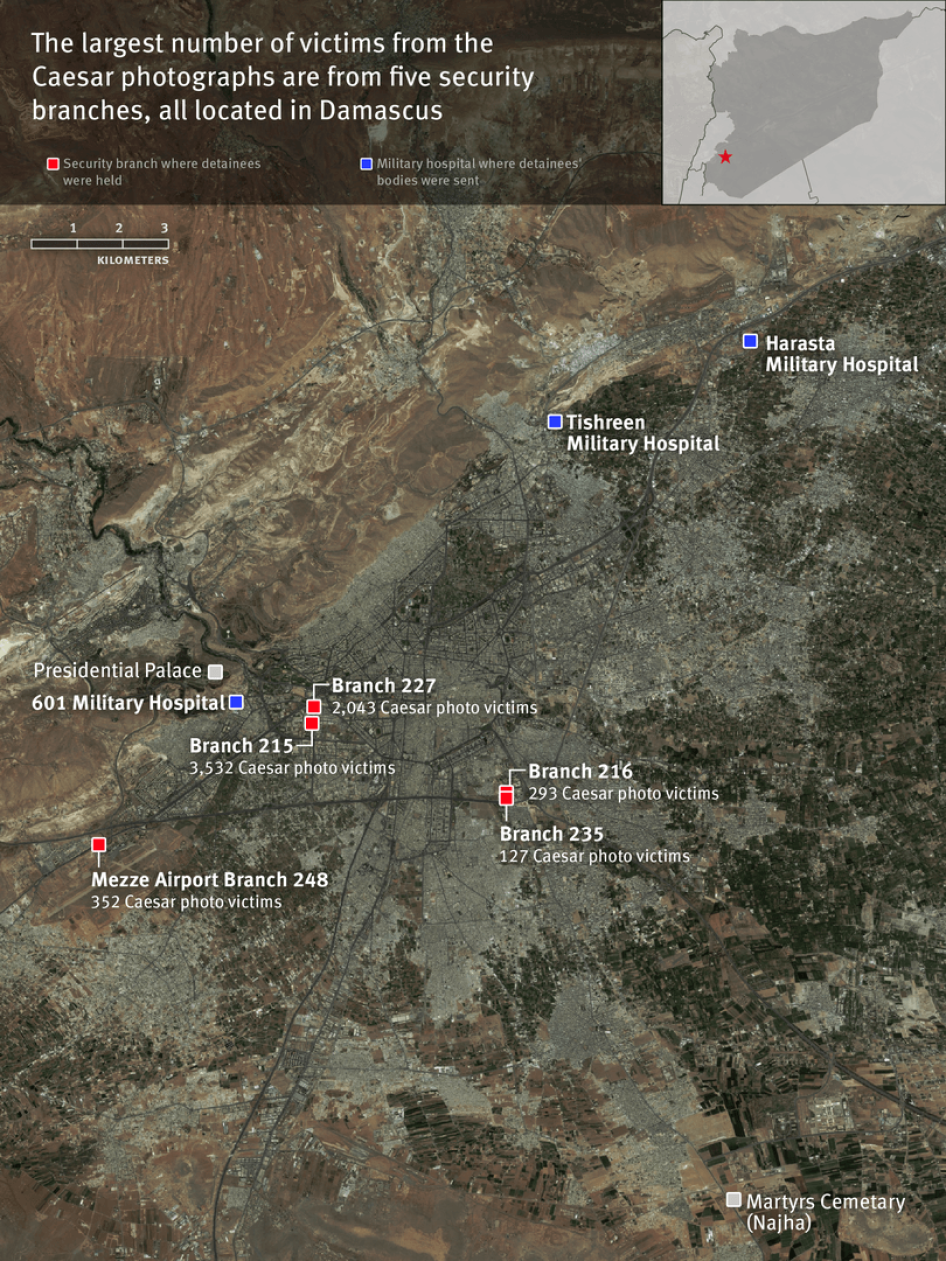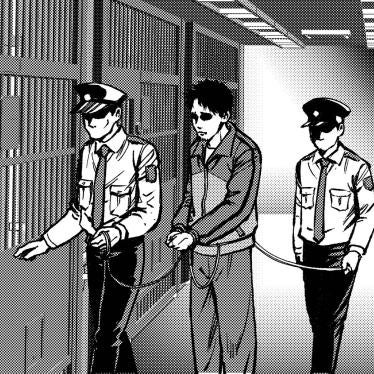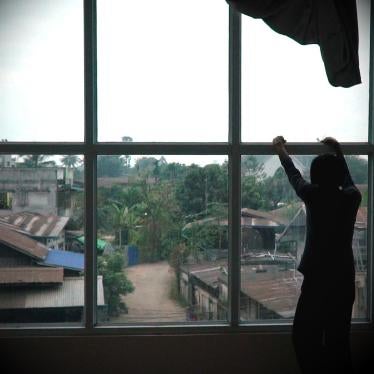(モスクワ)— 政府に拘束されている最中に死亡した2万8,000人超の写真がシリアから秘密裏に運び出され、世界に公表されたのが2014年1月。ヒューマン・ライツ・ウォッチは、9カ月にわたる調査を行い、これらの写真に秘められた一人ひとりの物語を明らかにした。本日、その詳細を動画とともに報告書として発表した。
Mass Deaths and Torture in Syria’s Detention Facilities
報告書「もし死人に口があれば:シリアの拘禁施設における大量死と拷問」(全86ページ)は、「シーザーの写真」として知られる一連の写真の信ぴょう性をめぐる新証拠を列挙したもの。本報告書では多数の犠牲者を特定し、主な死因も明らかにした。ヒューマン・ライツ・ウォッチは検証した27件のケースで33人の遺族と友人を探し当て、聞き取り調査を実施。ほかに、拘禁下で人びとが死に至ったのを目撃した元被拘禁者37人や、写真の大半が撮影されたシリア政府の拘禁施設または軍病院で働いていた亡命者4人からも証言を得た。加えて衛星画像およびジオロケーション技術を用いて、遺体写真の一部が、首都ダマスカス中心部に近いメッゼ地区の第601軍病院の中庭で撮影されたものであることも確認した。

ヒューマン・ライツ・ウォッチ中東局局長代理のナディム・フーリーは、「写真のほぼ全員に、彼らを愛する親、妻、子、そして友人がいた。家族や友人は何カ月から何年もかけて、必死にこれらの人びとを探し続けていた」と述べる。「私たちは細心の注意を払って、何十件もの個人ストーリーを検証した。シーザーの写真は、シリアでの人道に対する罪に対する、信ぴょう性が高く、痛烈な証拠であると確信している。」
シリア政府最大の後ろ盾であるロシアなど、シリア和平交渉の可能性について協議している国々は、シリアに今も何千人もいる被拘禁者の運命を最優先すべきだ。関係国はシリア政府に対し、国際監視団体に全拘禁施設への即時アクセスを与え、シリア諜報機関が被拘禁者の強制失踪と拷問に手を染めるのをやめるよう、強く求めなければならない。
Meet the doctor who saw the horrors of the Caesar Photos first-hand in Syria. >>
2013年8月にシーザーという暗号名の軍関係者がシリア国外に亡命し、その時5万3,275枚の写真も持ち出した。ヒューマン・ライツ・ウォッチは、シリア系反政府政治組織「シリア・ナショナル・ムーブメント」から、シーザーがこの組織に渡したすべての写真を入手。本報告書はうち2万8,707枚の写真に焦点をあてている。入手可能な情報から検証した末、これらの写真には、被拘禁下でまたは拘禁施設から軍病院に移送されたのちに死亡した少なくとも6,786人が含まれていることがわかった。残りは攻撃現場か、政府軍兵士ほかの戦闘員、あるいは攻撃や爆発、暗殺の巻き添えになった一般市民の遺体の写真だった。
シーザーの写真に写っていた6,786人の大半は、ダマスカス市内にある5つの諜報機関支部に拘禁され、遺体はその後市内の少なくとも2つの軍病院に移送された。病院への移送の期間は、シーザーが写真ファイルをコピーして職場から持ち出し始めた2011年5月から、シリア国外に脱出した2013年8月までだ。「人権のためのシリア・ネットワーク(Syrian Network for Human Rights)」は2011年3月以来、シリアで逮捕・拘禁された11万7,000人超を記録し続けている。
ヒューマン・ライツ・ウォッチは、シリア政府の拘禁施設にまん延する拷問、飢餓、暴力、疾病の証拠を確認。調査員たちが写真の27人の身元を特定した上で、シリア諜報機関による逮捕、拘禁下の虐待行為および拷問を調査・検証した。逮捕の様子に関する証言を遺族から収集し、あざや傷あと、刺青などの身体的特徴を比較、かつ同時期に同じ施設、ときには同じ房に拘禁されていた元被拘禁者がもたらす証拠も探した。これらデータとシーザーが収集したファイルに含まれる情報、ならびに写真中の遺体の上に置かれたID用の白いカードにある情報を付き合わせた。今回の検証は、法病理学や法に基づいたものではないが、本報告書で取り上げたケースは、複数の情報源から検証できたもののみである。
















特定できた犠牲者のなかには、逮捕時は14歳だった少年と20代の女性活動家もいる。聞き取り調査に応じた27人の遺族全員が、数カ月から数年ものあいだ愛する家族の行方を探していたと答えた。その多くが、様々な政府または諜報機関関係者である仲介者に多額の金を支払って、関連情報を得ていたという。うち正式な死亡証明書を受け取った遺族はわずか2人で、死亡原因は心不全、または呼吸不全とされていた。埋葬のために遺体を引き取ることのできた遺族はいない。
ヒューマン・ライツ・ウォッチは、19人の犠牲者の写真を「人権のための医師団」に所属する法病理学者チームと共有。同チームが虐待行為の痕や死因の証拠を写真から分析した。その結果、数種類の拷問、飢餓、窒息、暴力的な鈍力外傷、そして至近距離からの銃撃による頭部外傷1件が特定された。
シーザー写真の大半の犠牲者と同様の施設に拘禁されていた元被拘禁者は、空気循環がほとんどない房にぎゅうぎゅう詰めにされていたと証言する。配給される食糧がわずかなため人びとは日々弱っていき、入浴もままならなかったという。皮膚病をはじめとする感染病が拡大していったが、十分な治療もほどこされなかった。
前出のフーリー局長代理は、「シーザー写真の人びとが、組織的にそして大規模な飢餓状態におかれ、暴力と拷問を受けていたことは明らかだ」と指摘する。「これらの写真は、シリア政府拘禁下での犠牲の一片にすぎない。何千人もの人びとが今同じ運命に苦しんでいるのだ。」
ヒューマン・ライツ・ウォッチの調査員たちは、衛星ジオロケーション技術と、 軍病院2つからの亡命者たちの証拠を用いて、写真の撮影場所を確認し、遺体に乗せられていたカードの暗号システムを解読した。
前出のフーリー局長代理は、「政府は死亡記録をつけ、ときには何十もの遺体をまとめて手続きする一方で、死因の捜査や、政府拘禁下の死を防ぐための手立てをなんら打たなかった」と指摘する。「シリアの和平を目指す関係者たちは、これらの犯罪を阻止し、人権侵害的な制度の責任者が最終的にその罪を問われるようにすべきだ。」
すべての拘禁施設に対するアクセスの許可を、国際的な監視組織に即時与えるのに加えて、シリア政府はすべての恣意的に拘禁された人びとと政治囚を釈放すべきだ。シリア政府の主要な後ろ盾であるロシアやイランはとりわけ、拘禁に関する国際的な監視組織が速やかかつ妨害なきアクセスを得られるよう、シリア政府に圧力をかける責任がある。
ウィーンでシリアの和平プロセスを協議している国際シリア支援グループ(ISSG)の参加国は、シリア内戦の全陣営が犯した広範に及ぶ人権侵害に関し、アカウンタビリティを実現するための取組みを支持すべきだ。重大な犯罪に関与した個人に対する恩赦の提案は拒絶されるべきである。いかなるシリアの移行期プロセスであろうと、最低条件として、拷問ほか重大な犯罪への関与で確実な証拠のある個人が、拘禁制度内で権限を持つ地位につかないことが必要だ。
フーリー中東局長代理は、「悪夢のような世界に拘禁されていた人びとの多くが、このまま苦しみ続けるくらいなら死にたいと思った、と証言した」と述べる。「これら証言者たちの切なる願いは、シリアで今も拘禁されている人びとを救うためにできる限りのことをしてほしい、というものだ。和平プロセスに関係する各国の責任は大きい。」
Ahmad al-Musalmani (Child), Victim from the Photographs
On August 2, 2012, when Ahmad was 14, he returned to Syria from Lebanon, where his family had sent him for safety reasons, to attend his mother’s funeral. He was traveling in a minibus with five other people.
An officer at a checkpoint took the passengers’ phones and found an anti-Assad song on Ahmad’s. The officer dragged Ahmad into a small room at the checkpoint, a fellow passenger told the family a day later. The rest of the passengers continued on in the minibus without him.
Ahmad’s uncle, Dahi al-Musalmani, was a judge for 20 years before he fled the country in March 2013. Dahi told Human Rights Watch that he went to see several government officials after Ahmad’s disappearance. He learned that Ahmad was likely in Air Force Intelligence custody, and paid more than US$14,000 in bribes attempting to secure Ahmad’s release, unsuccessfully. He eventually fled to Jordan after family members told him he was wanted for arrest.
When the Caesar photographs were released, Dahi searched for Ahmad among them:
Rehab al-Allawi, Victim from the Photographs
Rehab al-Allawi, a Damascus resident originally from Deir al-Zor, was an engineering student at Damascus University before the uprising in Syria. Hers was the only photograph of a woman, among the Caesar photographs of detainees’ bodies.
Rehab was about 25 when the Raids Brigade, a special unit of the military police, arrested her on January 17, 2013. Rehab worked in one of Damascus’s local coordination committees – loose networks of activists – assisting internally displaced people who had fled Homs.
After her arrest, the family sought information through personal contacts within the Syrian government. They paid more than US$18,000 to various officials in the Syrian military and security services to try to get information about her and to secure her release but their attempts did not succeed.
A former detainee, Hanadi, told Human Rights Watch that she was detained with Rehab for more than three weeks in the 215 Branch Military Intelligence facility.
“We spent 24 days together in the cell, next to each other,” Hanadi said. “She wanted to see her parents. She would always speak about her brothers and sisters. She was scared for her family.”
Hanadi was transferred to Adra Prison after three and a half weeks. She never saw Rehab again.
In March 2015, after the Caesar photographs were published online, a cousin called the family and asked if Rehab’s photo might be among those released. “She looks just like Rehab,” the cousin said.
Though the family recognized Rehab, they asked former detainees who had seen Rehab in prison for confirmation, as her appearance had changed during her detention.
Hanadi said:
“If you took pictures of the detainees now, you would see people who looked like those that are in the Caesar photographs, only they would be alive….The ones who died are the lucky ones.”
–Dr. Sami, former 215 Branch detainee
“When I went inside the cell, someone knew me. When he lifted his head, [I saw] his teeth were broken. He was severely, severely emaciated. He had very weak and short hair. I said, ‘You know me?’ He said, ‘Yes, I’m your nephew Mohammed. I’m the one with the supermarket next to your clinic.’ He started to cry. He hadn’t seen himself, he’d been detained for ten and a half months.”
–Dr. Karim Mamoun, former 215 Branch detainee
Quotes from Defectors
“I know this place from the photographs stone by stone, brick by brick. I lived there 24 hours a day. I had to carry [the bodies] myself.”
–Suleiman Ali (not his real name), former conscript who worked at the 601 Military Hospital
“When the corpses arrive, [the forensic doctor, who is also an army officer] asks how many corpses there are, and then she asks [conscripts] to wrap them up. She gives each body a third number on a bandage. She writes on the register: the number of detainee, the branch number, and the hospital number [examination number]. Then they are put in the [morgue] refrigerator.”
–Fahed al-Mahmoud (not his real name), military defector who served at the Harasta Military Hospital in Damascus and witnessed bodies being registered











